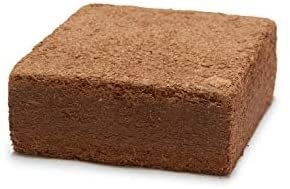WHAT KIND OF SOIL SHOULD I PUT IN MY CHAMELEON TERRARIUM?
Once you have purchased the terrarium and the UVB lamp, let's set up the terrarium. But where to start?
First you need to decide whether you want a standard or a bioactive terrarium?
Let's start our description with the traditional method:
This equipment requires less material, as it is sufficient to put a few centimetres of soil in the bottom of the terrarium. The choice in the stores is usually very large, so it is easy to get lost in the variety. Always aim to provide the most natural habitat for your pet, and choosing the right substrate is essential. But what is good soil?
The most suitable is coconut fibre, which you can usually buy in block form (see at the end of this article for how to use it)
Why use coconut fibre?

- - Tiny particles accidentally swallowed do not cause major problems in the digestive tract
- - Absorbs water dripping from plants, no water remains in the bottom of the terrarium
- - Makes cleaning the terrarium easier, removing droppings in one step
- - Neutralises odours from excrement
- - Potted plants can take root in the soil, making them grow even more beautifully
- - Environmentally friendly
- - Natural
- - Sterile
- - Inexpensive
- - Easy to use
We do not recommend the use of coir, bark, coconut chips, gravel, stones and other coarse-grained soils. This is because accidental consumption can damage the chameleon's oral cavity, tongue or cause a blockage in the digestive tract, which can be fatal for your pet.
Let's make his/hers home safe for him/her!
Note that this problem can be avoided if feeding is done from a bowl. Of course, some food may still come out of the bowl, but there is less risk of injury.
Keeping the coconut fibre clean
If you remove the larger dirt and plant debris every day, you can keep it clean for a very long time.
However, during the molting of the chameleon, small pieces of skin can fall off, which are very difficult to pick out by hand. If the soil layer is thick enough, just sweep up the top 1-2 mm with your hands and remove the skin with the coconut fibre.
A complete soil replacement is recommended 1-2 times a year.
Preparation of coconut fibre:
Put the block in half a bucket of water and let it steep. After a short time, it will absorb all the moisture and swell many times over. When it is completely soaked, take it out and squeeze out the excess water. Now you can safely spread it around the terrarium. Sometimes you may find large pieces of coconut fibre in the water, which should be removed before it is used.
Of course, other soils may also work, many people use peat or artificial grass as a terrarium substrate. It may be worth trying several different soils that meet your requirements.
Subscribe to our newsletter to be the first to read our new content!
You can subscribe at www.chameleoncamp.eu at the bottom of the mainpage!
